
The Best of Storytelling: This Girl Can
- Written by Leah Dennison
It’s easy to forget how far advertising has come. In a few decades, we’ve moved from slogans like ‘Blow in her face and she’ll follow you anywhere’ to the dawn of ‘Woke Washing’ – a post-Campaign For Real Beauty era where ethical and progressive values are appropriated to make more profit, while hiding the dark side of conventional capitalism.
During Covid-19, we’ve all become well-versed in the formulaic rhythm of vacuous ad breaks – where voiceovers have graduated from “buy a Toyota” to “this is a difficult and uncertain time for us all… buy a Toyota”.
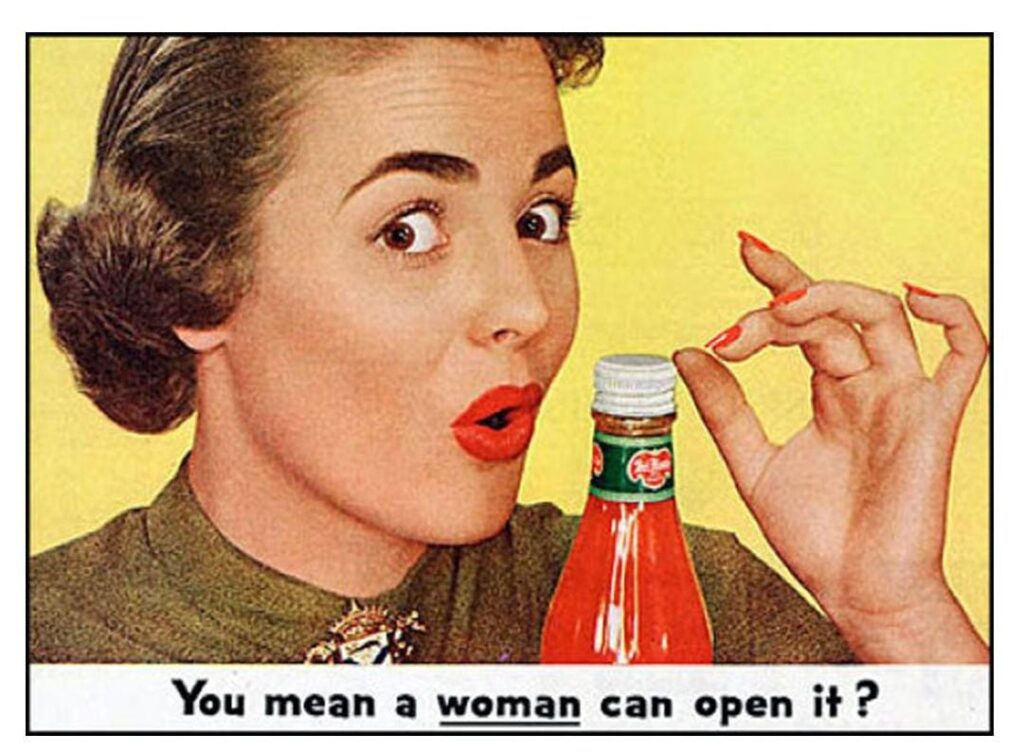
But between Kendall Jenner stopping a riot with a Pepsi can and M&S single-handedly solving homophobia with their LGBT sandwich, there are a few beacons of light that prove conscientious advertising can be achieved. This Girl Can is one of them.
The campaign soft-launched in October 2014 and has spanned three distinct phases. In this post, I’m going to delve into why the campaign was a success, both in terms of masterful storytelling and proven impact metrics.
1. The only thing that can replace a story is a better story
The first This Girl Can TV ad was aired in January 2015.
In June of the same year, an ad for Protein World appeared in the London Underground featuring a bikini-clad blonde that asked, “Are you beach body ready?” The ad sparked controversy and more than 200 people complained to the Committee of Advertising Practice and Advertising Standards Authority, claiming the ad promoted unrealistic body types and fat-shaming.
This public outcry eventually led to the formation of new advertising regulations that finally took effect in June 2019.
The regulations banned:
- Ads that show a person failing to achieve a task specifically because of their gender
- Ads that suggest transforming your body will make you romantically successful
- Ads that belittle men for carrying out stereotypically ‘female’ roles or tasks
- Ads that emphasise the contracts between a girl’s stereotypical personality and a boy’s
- Ads aimed at new mothers that tell them that keeping a perfect home or attractive body is a priority for their emotional wellbeing
During the four years it took for those regulations to come into effect, This Girl Can confidently paved the way in showing the industry how you can break the mould for behaviour change campaigns by doing something different, and centring proven insights at the heart of their campaign – with not one airbrushed model in sight.
The campaign was born from a desire to tackle the fact that despite increases in the overall number of people being active in England, women persistently remained less active than men. Sport England’s vision was to transform people’s lives through sport and physical activity. To achieve this, they needed everyone in England regardless of their age, background or level of ability to feel able to take part.
Compare this:
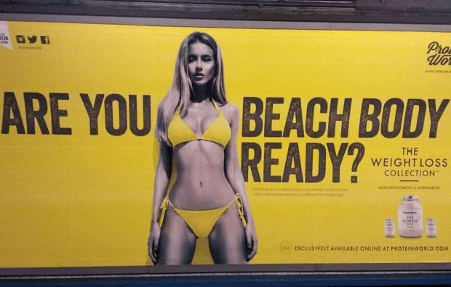
To this:
This Girl Can, TV advert: 2015
2. What makes it a better story?
Firstly, the heart of their story was built on insights from their audience. Sport England began by conducting research into the barriers that were stopping women from exercising. These research findings were traced back to something universal, fresh and emotionally powerful: the fear of judgement.
Women were worried about being judged on their appearance during and after exercise; on their ability, whether a beginner or ‘too good’; or for spending time exercising instead of prioritising their children, family or work.
This insight told them that women felt distanced from exercise due to the usual portrayal of women and exercise in society. By celebrating a realistic vision of women and exercise in the UK, Sport England were able to create a campaign to provide women with inspiration and support to liberate them from the judgements that hold them back.
In story terms, their compelling villain leads their strategic thinking.
They then went on to bring to life their strategy of celebrating the reality of exercise by using story patterns we instinctively understand in their first advert.
You can see it mapped out using our Canvas framework below:
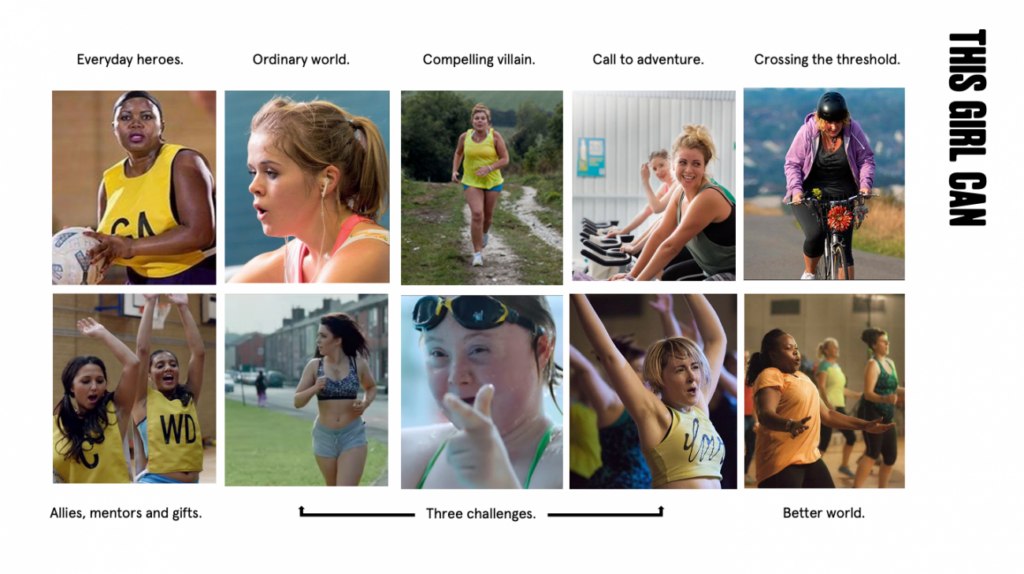
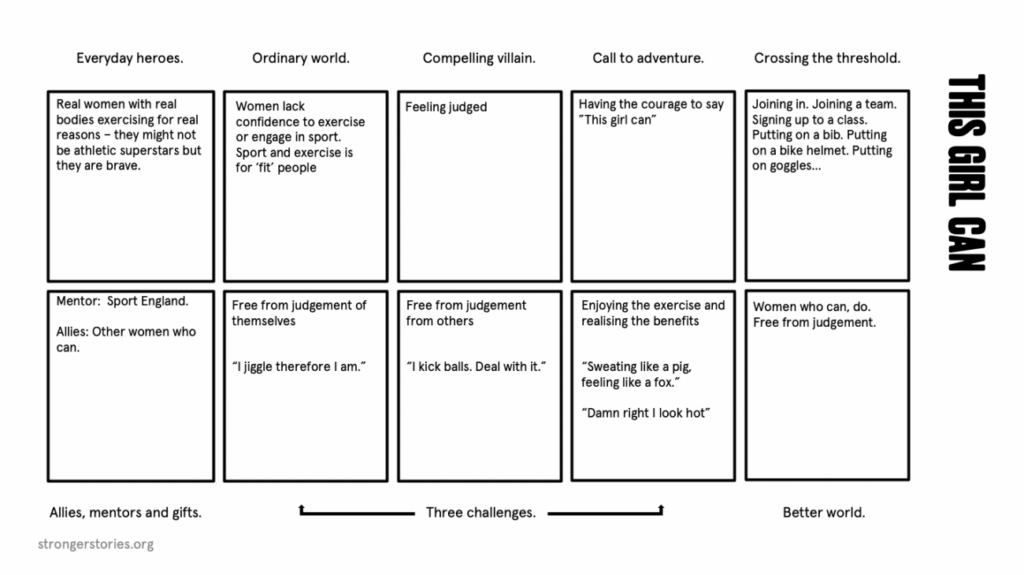
The story type that This Girl Can employed was an interesting mixture of Comedy combined with Overcoming The Monster.
This cocktail of tone is hard to balance but is done masterfully here, balancing seriousness with humour and hope. Rather than playing a tragic narrative of obesity and gender gaps between exercise demographics, the viewer is given an uplifting message with injections of humour viewers want to identify with, resulting in a positive “don’t give a damn” attitude. The comedic slogans also worked hard at helping to boost viral shareability on social
3. Don’t get stuck in broken systems, reinvent them
The offer at the time wasn’t relevant for many women who wanted to be active. Being shamed and guilt-tripped into exercise clearly wasn’t helping women to become active. Sport England listened to what their audience cared about and tailored their activity, marketing and customer experience to deliver what they wanted. They didn’t expect women to change to fit sport and exercise. They changed their offer to suit the women they wanted to target.
They stopped just talking about ‘sport’ as for many women, the word comes with baggage. Its traditional image can trigger negative associations for many women, and they addressed this by considering how they could present the different experiences women will have when getting active.
They differentiated sport and exercise from other interests by promoting (not preaching) the additional benefits. As well as the traditional health benefits, which many women do already recognise, sport and exercise can provide the opportunity to socialise, develop skills and spend time with the family.
Making sport the ‘norm’ for women relies on local women of all ages, sizes and faiths not only becoming active but celebrating it and encouraging others to join in. Seeing is believing, so showcasing relatable and diverse women and girls visibly enjoying being active, at their own pace and somewhere local, feels more attainable. Sport England shot exercise activity into real communities to attract new people by becoming part of their everyday sphere.
In fact, all of the women that feature across the campaign were actually street-cast after being found exercising in real locations across the UK.
4. Keep the story moving
The campaign of ‘This Girl Can’ was split into three phases with heaps of wrap-around activity.
Realisation: the first phase sought media exposure to create and curate conversation, and involved a unique social algorithm that identified women Tweeting their exercise anxieties and started proactive conversations to support and encourage confidence in women who needed a boost.
Inspiration: the campaign’s second stage focused on inspiring women on a mass level through broadcast creative on primetime TV, in cinemas, a YouTube takeover, digital and social ads and a national poster campaign.
Self-Identification: the last stage of the campaign was about helping women feel closer to the campaign and motivating them to start exercising, leading to an extended social reach, as women started sharing the content they came across. This phase focused on encouraging women to self-identify through an app that allowed them to create their own motivational content.
The campaign was rebooted and redeveloped in 2017, and again in 2020, with campaigns encompassing a wider age range of women, moving their demographic from 14-40 up to a wider reach of 14-60 – one hell of an audience.
We’ve mapped these later campaign stories using the Canvas framework so you can see how each subsequent campaign has adapted and updated the This Girl Can story to include more members of the target audiences over the years.
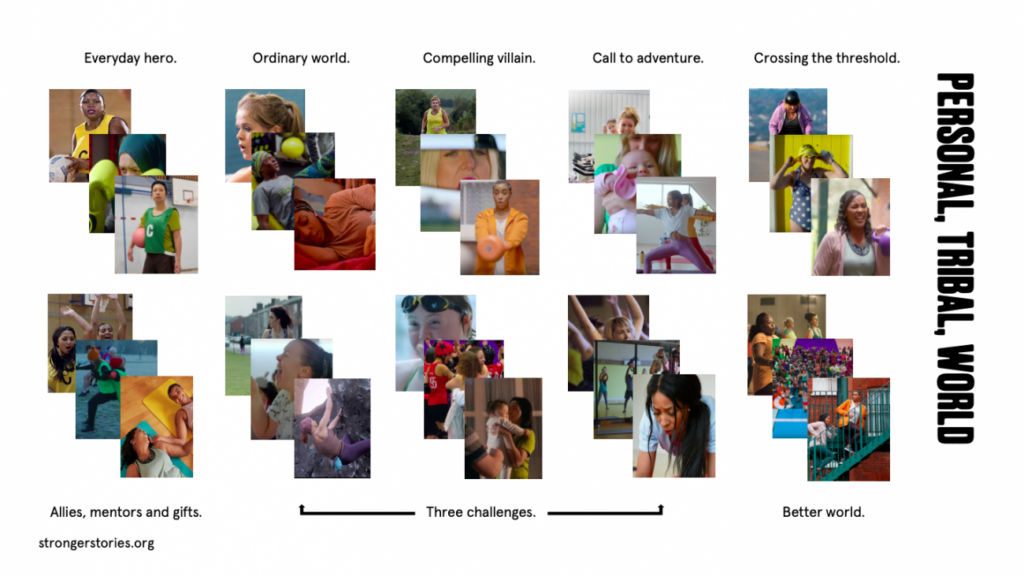
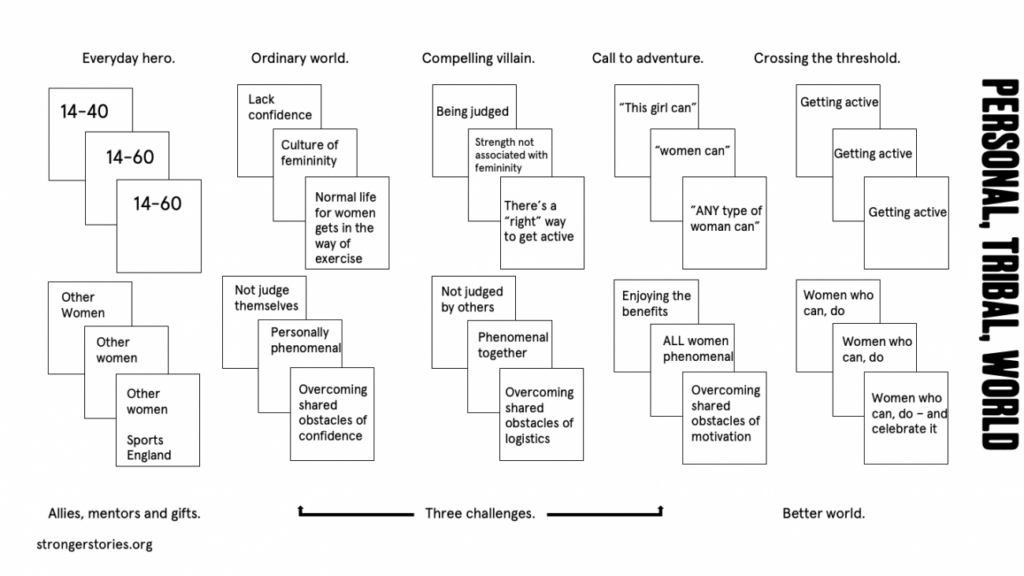
5. Track metrics that matter
Alongside a huge swathe of media coverage statistics including more than 37 million total campaign views, a combined and growing social community of over 600k, and 10 consecutive days of media coverage in the UK – the most important impact was the number of women motivated to start exercising.
2.8 million women aged 14-40 who recognised the campaign took on a physical exercise and over the past five years the campaign has helped more than 500,000 more women to be active once a week, every week.
While public trust in advertising in 2019 had hit a record low of 25%, research claimed people in the UK are still relatively positive about the industry’s possible impact on society with 42% of people agreeing that advertising had the power to help make the world a better place.
So rather than tracking how many cans of Pepsi need to be sold to make the world (and its investors) happier, hard evidenced proof goes a long way for campaigns that fight for real behaviour change. This campaign really can.
Share:
Grow Your Good Idea Faster
New ideas are precious. Win support by learning how to create and tell a stronger story – sign up to join for free.

Related posts
What heroes and villains across cultures can teach us
From caped crimefighters to the megalomaniac mastermind, societies around the world have always used storytelling to...
How Drag Race Changed The Narrative
In the lead up to Brighton Pride, we decode powerful story insights from one of the world’s most popular reality TV shows.
Taking the First Step: The Power of Origin Stories
When it comes to courage, taking the first step is crucial. Instinctively, we trust people more when we understand a...
Learn from the strongest stories about change
We’re working hard to walk the talk.
We’re proud to have been awarded The Blueprint and B Corp status in recognition of our work towards creating a better world.

